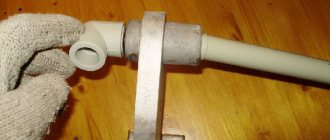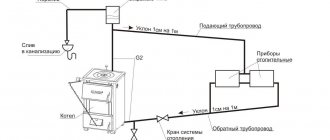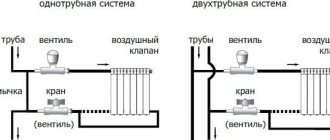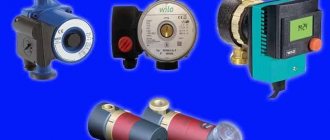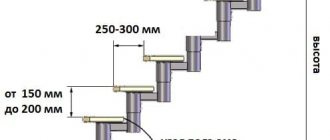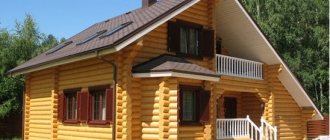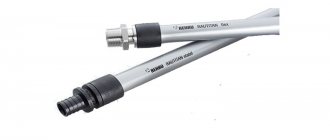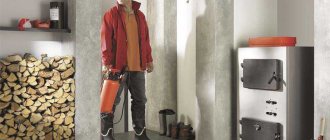Advantages and disadvantages of electric heating in an apartment
Choosing a heating system for a city apartment is a complex and responsible process.
For residents of apartment buildings with central heating, the issue of heating their homes is easily resolved. It's getting cold, so wait for the heating to turn on. That category of citizens who have decided to independently take care of their own comfort is faced with a complex and difficult choice - which type of autonomous heating for an apartment in a multi-storey building to prefer. For the owner of the apartment, it is important that the system is as efficient, safe to use and economical as possible. Of all the types of autonomous home heating that exist today, all of the listed criteria are met by electric heating.
The heating season, which many of us look forward to, no longer depends on a specific date for apartments with electric heating. With the help of electricity, you can achieve an acceptable temperature in your apartment at any time, create the necessary comfort and microclimate.
Features of electric heating
The main problem with such heating is, oddly enough, electricity itself. When you choose this heat source, you are essentially saying to yourself: I dedicate heating of my home entirely to electricity and am willing to suffer if it goes out and becomes scarce during the heating season.
Of course, in many regions the situation with electricity is not bad. But the risks that its power will drop in winter are very high. After all, there may be quite a few people in your area who heat themselves with electricity. And if the house is also large, then the likelihood of a lack of capacity increases even more.
You should also not ignore the fact of the cost of electricity. Today this is essentially the most expensive heating method, but also the safest. What methods of heating with electricity exist today? Let's figure it out
Heating system installation
It is possible to positively resolve the problem - how to install heating in a private house (the diagram is given above) if you follow certain rules and the sequence of work.
Installation work begins with the installation and subsequent piping of the boiler. Gas boilers with a power of up to 60 kW are installed in the kitchen. All rules for installing boilers are described in detail in the instructions for them. Piping a heating boiler is the process of connecting the necessary equipment.
There are two ways to install a heating circuit from gas and water (metal) pipes - welding and using threaded connections. Of course, you can quickly create a system using the welding method, but it will turn out to be non-separable. By connecting the system pipes with threaded connections, you can easily change the configuration or replace any section of the pipeline at any time. For any installation method, the connection diagram for heating radiators in a private house requires special attention, and it must be drawn and calculated in advance.
The procedure for calculating water heating schemes with your own hands
Calculations of thermal installations require a serious level of preparation from the designer. However, as an amateur method, we can recommend the following rough methods:
- to determine the boiler power: calculate the total volume of a private house by summing the volumes of each room. The cubic capacity of all rooms should be taken into account, regardless of the presence or absence of radiators in them. For example, let the volume of the house be 300 m3. The amount of energy required to heat 1 m3 depends on the region. For buildings in the European part of the Russian Federation, 40 W/m3 is required, in the south - 25 W/m3, in the north - 45 W/m3. Therefore, for a private house with a volume of 300 m3 in the Moscow region, you will need a boiler with a capacity of 12,000 W. Adding a margin of 20% and converting W to kW, we get 14.4 kW;
- To calculate the number of battery sections, the area of the room and the power (heat transfer) of one section are taken into account. The power depends on the material of the heating device (indicated in its passport). Next, you should divide the square footage of each room by the value of the rated heat transfer. By summing up the number of sections, a small margin of thermal performance is also added to them;
- the pump for systems with forced circulation is selected taking into account the length of the pipeline and the cross-section of the pipes. The algorithm for their calculation is described in detail in the story on the video:
Electric heating of a private house
To some extent, organizing electric heating in a private house is easier than in an apartment. The power consumption limit is much higher; it is possible to control and put in order all the wiring, starting from the power line. From the list above, a water heating system with an electric boiler is most suitable for a cottage. The reason is simple: it is necessary to ensure the use of different energy sources, and not just electricity. This means that you need to select a boiler, install it and install a one- or two-pipe system.
Currently, there are 3 types of household heat sources on the market that are used to provide electric heating for a home:
- heating elements;
- electrode;
- induction
Electrode boilers are cheaper than heating elements, but are not as well equipped. You will have to buy the circulation pump and expansion tank separately and install it yourself. So the installation of the unit as a whole will be more expensive.
Plus, you need to maintain the chemical composition of the coolant so that it contains the amount of salts necessary for the electrode heating process. And one more important point: an electrode boiler cannot operate at half capacity, but only at full capacity.
Temperature control occurs in on/off mode. The purchase and installation of an induction heat generator in a private house will require the highest costs. In terms of piping, it is similar to an electrode boiler, since it only includes a control cabinet with automation. The unit itself is reliable and durable, but has a high price.
The most economical electric heating
In fact, there is a way to save significantly on electric heating at home. And consumption will be up to 5 times lower than that of a simple heating option. This method is at the same time the most expensive and is not suitable for everyone. Whether he is the best or not is up to you to decide. But it’s definitely worth talking about.
Imagine how many resources the earth gives us and how much heat we can take from its depths for our use. Everything that has a positive temperature can give us heat.
Now imagine a device that can convert earth's energy into thermal energy. It sounds very futuristic, but such a device has been around for a long time and is called a heat pump.
Heat pump
A heat pump can take useful heat from the air, from the ground, from water and convert it into thermal energy for heating the house. Such a device operates on electricity and, consuming 1 kW of electricity, can produce 5-6 kW of thermal energy.
The heat pump essentially replaces the boiler and performs its main function. And its main disadvantage, as you probably guessed, is its price.
Due to the cost of the pump, the payback period is quite long and in certain conditions the pump may not even pay for itself, but simply fail ahead of time. But in the near future this unit will be in great demand. After all, electricity is becoming more expensive, and heat pumps are becoming cheaper every year.
Advantages of heat pumps:
- A sharp reduction in energy costs. This is almost the most key factor in choosing a heat pump.
- Modern environmentally friendly equipment
- Know-how your neighbor will envy
The pump also has disadvantages:
- High price of equipment
- Long payback period due to the fact that electricity in the CIS countries is still not so expensive
- Complex equipment, the repair of which can cost a pretty penny
Suitable equipment for specific conditions
First of all, it must be said that for each specific case you need to choose the right electric heating system for your dacha. It all depends on how often you visit your country house and for what purposes it was built for you. Let's consider each of the existing situations in more detail.
Rare visit
If you visit your dacha plot extremely rarely, especially in winter, then of course there is no point in installing a capital heating system at your dacha yourself. Here it is recommended to use the connection of electric convectors, fan heaters or oil radiators. Convectors can be wall-mounted, floor-mounted, or installed on casters. Each type of design has its own advantages and disadvantages. We recommend that you immediately familiarize yourself with the tips on choosing an electric convector in order to buy the most suitable model for heating your dacha.
As for fan heaters and oil heaters, they allow you to warm up the room in the shortest possible time, which is exactly what you need for a rare visit to the dacha.
Weekend getaway
If the country house is represented by an insulated capital building, it already makes sense to make better electric heating for the country house yourself. The best solution in this case is a heated floor, which allows you to warm up the room in a short period of time and maintain a certain temperature in the house for as long as needed.
A heated floor alone may not be enough if you decide to install electric heating in a dacha with an area of 100 square meters or more. In this case, it is recommended to supplement the system by connecting infrared heaters that have high efficiency and relatively low energy consumption. A combination of heated floors and IR panels, as shown in the block diagram above, will allow you to quickly and inexpensively warm up a country house for a weekend getaway in winter.
Frequent visit
Well, the last option, which is the least common, is a country house in which the owners spend a significant part of their time. Under such conditions, it is necessary to take care of high-quality heating, and if there is no gas at the dacha, be sure to make electric heating yourself.
It is no longer rational to use equipment with high energy consumption - fan heaters and oil heaters. A more competent solution would be to connect an electric boiler operating together with water radiators.
In addition, it is recommended to connect electric heated floors in the rooms, and, if necessary, install IR ceiling panels controlled by temperature controllers. Such a dacha heating system does not require the installation of a chimney, obtaining various permits and calling a specialist for installation work, which makes it the best if there is no gas on the site.
We immediately recommend watching a video with an overview of a modern electric heating system, which in a short period of time has gained many positive reviews on the Internet:
Video review of an economical heating system for a large country house
The procedure for assembling a boiler with heating elements with its own rivers
Before you make an electric boiler with your own hands, you should make sure that you have a reliable power supply line. Only equipment with a power of no more than 6 kW can be connected to ordinary networks with a voltage of 220 V and a frequency of 50 Hz. If a more powerful boiler is required, it needs a three-phase wiring and a separate input.
So, we begin assembling a homemade electric heating boiler from a pipe with a cross-section of 159 mm and a wall thickness of 10 mm. This pipe will serve as the boiler body. It will require either a factory-made hemisphere with a cross-section of 159 mm and a thickness of 10 mm, or sheet metal with a thickness of 8 mm or more of a similar section.
The boiler roof, into which the heating elements will subsequently be embedded, can be made from an 8 mm thick channel.
We cut a ¾-inch coupling into the boiler dome. We will screw the drain valve into this coupling. In addition, you will need 2 pipes with a cross-section of 1 inch for inflow and return. The threads on the pipes can be made both internal and external. It all depends on which one you are more comfortable working with.
To relieve excess pressure, you need to prepare a pipe for inserting the bypass channel. You will also need 3 adapters, each of which will have a heating element for the electric boiler screwed into it. Another adapter will be needed for the temperature sensor. In addition, you will need holders for automation.
Please note that it is advisable to cut the threads on the pipes and adapters immediately.
Prepared pipes with threads, the same as on heating elements, must be immediately screwed into the adapters. This is necessary so that the threads are not damaged during welding to the arch. To mark the insertion points of the heating elements, the outer diameter of the pipe must be divided into 6 equal sectors according to the radius size. Then we draw three identical sectors strictly at an angle of 120°.
The next step is to start cutting. Having finished with the markings, using a plasma cutter we cut out holes for the pipes for the heating elements. They should be cut only along the outer contour. With all other pipes this is not of fundamental importance.
Let's start welding work. First we intercept the pipes at several points so that they do not lead. Then we check the accuracy of the location, if necessary, lightly tap with a hammer, and then make a continuous seam. It is important that the adapters for heating elements in an electric boiler for heating with your own hands protrude 1 cm above the surface of the boiler roof.
Next, you need to make sure that the heating elements fit completely inside the body of the electric boiler. Therefore, after applying a continuous seam, it is necessary to screw the heating elements into the adapters.
Let's start cutting out the vault from the channel. In its center we make a hole for the air valve pipe, after which we weld the pipe itself. We make a hole on the side for the temperature sensor and also weld a pipe under it.
All protrusions, burrs and welding residues must be thoroughly cleaned using a grinder. The inner surface of the arch platform must be perfectly flat. The pipes for installing heating elements will protrude only 1 cm from the outside.
We got a fairly powerful electric boiler with our own hands with 3 heating elements. If you need a simpler unit, using the same principle it can be assembled using 1 or 2 heating elements.
Which option is better to avoid?
We talked about cheap and effective systems for economical heating of a private home, but we would also like to point out the most expensive options that should be avoided. The top of the ranking is occupied by oil radiators. They are known to everyone for having high power, so when working in winter you can see a noticeable increase in electricity consumption.
Not only do these products have high power, but their heating efficiency is also very weak. For example, an IR panel of the same dimensions and the same power will make the house warmer faster, so it is better to give preference to it.
In addition, an infrared heater is installed on the ceiling or wall, thereby not occupying free space, which cannot be said about electric radiators.
Another not recommended option is fan heaters. These devices not only burn oxygen, but also “drive away dust” and are also noisy. The effectiveness of their use is not very high, because... between the ceiling and floor, the temperature may differ by several degrees, despite the fact that the power of the products is high (from 1.5 kW).
Choosing the right system
Depending on the area of the living space and the quality of wall insulation, a suitable option for autonomous electric heating of the apartment is selected. If you are the owner of a one-room or two-room Khrushchev house, a heated floor system in combination with electric convectors or IR panels can cope. Combinations with infrared heaters are more profitable and efficient, because... thermal radiation will be directed from top to bottom and all the heat will circulate in the lower part of the room. Heating an apartment with electric convectors is better only because the devices do not dry the air and do not have a negative impact on human well-being. There are many reviews that IR heaters with constant radiation have a negative effect on health, which is their disadvantage.
You can find other advantages and disadvantages of infrared heaters in the corresponding article. Yet, as statistics show, in 2021 such devices are actively purchased for household use!
As for electric underfloor heating, it is indeed very popular and effective. Anyone can install a heated film floor under a laminate, even an electric kettle. In addition, the material can only be used to make heated paths in the apartment, and not to lay film over the entire floor area. This heating option will have a positive effect on energy savings and at the same time will effectively warm the room.
If you live in a three-room or four-room house, then it would be more reasonable to use the connection of electric water heating in the apartment. This is due to the large total area of the rooms, which will require a full-fledged, powerful heating system. For example, if the area is 130 sq. m., with the calculation of 1 kW/10 sq. m. it will be necessary to install no less than a 13-kilowatt bundle of electric heaters. Of course, in winter you will spend a lot of money on the operation of an individual electric heating system. In addition, to use this option, the wiring must be powerful and able to withstand high current loads. In this case, you cannot do without replacing the electrical wiring in the apartment, which, again, will hit your budget. At the same time, if you use water radiators powered by an electric boiler, the heating will be autonomous and less expensive, which will allow you to “kill two birds with one stone.”
We recommend that you immediately read the article on how to properly connect a boiler to the network with your own hands so that you don’t make mistakes and the system lasts longer!
Electric heated floors
The most popular option for electric heating of a private home is based on the use of a heated floor system. Such heating can be organized in any room of the house, even in the bathroom.
Electric heated floors
If desired, you can opt for a “smart” model of electric heated floor. Special sensors and other automation equipment will allow the system to determine the temperature in the room and independently change the power to ensure the most comfortable conditions. Installation of such heating is carried out in several stages.
Electric heated floors
First stage. Thoroughly clean and level the base using a concrete screed.
Second phase. Place insulation and waterproofing material on the dry base.
Third stage. Lay the heated floor structure. There are several modifications. The instructions for the system you choose will provide the optimal installation scheme.
Fourth stage. Install the thermostat and other related elements, and then connect the heated floor to the mentioned electronics. Manufacturers provide recommendations for the placement of all mechanisms, as well as their connection to each other, in the instructions for their products.
Fifth stage. Pour the concrete screed and wait until it dries.
Sixth stage. Apply the selected finishing coat to the dry screed.
Features of pipe routing
Piping is carried out using special tees or fittings. One part of the pipe must be inserted inside the nozzle, and then the tee is put on top of the coupling part. Pipeline layout:
- vertical;
- horizontal;
- single-pipe;
- two-pipe;
- lower
Most often, in private households, wiring is used along the perimeter of the entire room. Heating of the connected pipe parts is carried out in a soldering apparatus, which allows for the most reliable and durable fixation of all elements of the installed heating system.
Many people want to heat their house with electricity, because this system is the simplest in terms of installation and safety. Heating a house with electricity is cheap - is it possible?
Comparative characteristics of water and electric heated floors are presented here.
Autonomous electric heating of a private household can become a practical and absolutely affordable solution to the heating problem only if the system is properly arranged independently, as well as the correct choice of the type and design of all installed equipment.
Features of two-pipe circuit wiring
The two-pipe system comes in several varieties. They have a different connection diagram for heating radiators in a private house, and a different vector of coolant movement.
In small private houses, the following types of two-pipe heating systems are used:
Brief characteristics of two-pipe systems
Dead-end system - the entire pipeline network consists of two arms (branches), one for supply and the other arm for coolant return. The movement of water occurs in counter directions.
Associated two-pipe system - the return arm serves as a continuation of the supply arm (branch), i.e. the system is looped. This heating connection scheme in a private house is deservedly popular.
Collector is the most expensive heating distribution scheme for a private house due to the need to lay pipes to each battery, and their installation is hidden.
Open "gravity" two-pipe system
Let's consider the heating system installed in a private house with our own hands; a two-pipe open circuit was chosen and an open tank was installed at the top point of the circuit.
The pressure that determines the speed of fluid movement in the “gravity” system depends on the height of the tank. The main advantage of a two-pipe system is that water flows to the radiators at the same temperature, and a clear separation of pipelines into supply and return makes it easier to automate control. For successful operation of the “gravity” system, a slope of 3-5 mm/m is ensured during installation. Due to gravity, any type of heating system can operate if the necessary conditions are created - the slope of the coolant supply lines for natural circulation. It must be taken into account that the “gravity” system can only work with an open expansion tank.
Closed two-pipe system
When installing steam heating in a private house, the scheme is chosen to be closed, and its type depends on the number of floors of the building. If the house is one-story, then two pipeline branches are laid - supply and return, and heating devices are connected to them in parallel.
And in order to install the heating of a two-story private house with your own hands, the wiring diagrams must contain the required number of liquid supply branches. One branch of the collector should power the batteries on the upper floor, the second branch should power the batteries on the lower floor. The water that has given up its heat returns to the boiler through the “return”. A closed system must have a circulation pump to create pressure.
Options for electric heating of a private house
Such a heating scheme involves the use of various types of equipment.
Boiler application
It is not uncommon to install an electric boiler for heating a 220V home. This device is a budget option and is easy to install.
Electric boilers are of the following types:
The diagram shows the principle of working with heating elements
Electrode model device
Installation of induction device
Selecting IR panels
When determining how to heat a house economically with electricity, you can consider the option of installing infrared structures. Such products do not warm up the air inside the rooms, but various objects. If in the version with a boiler the air masses move upward and then cool, then in this case the hot flows are directed to the floor.
Infrared designs do not take up much space
If you add thermostats to IR devices, they will work more efficiently. One controller is enough to control three heaters. This equipment is economical to use, but expensive in terms of installation and construction costs. IR devices consume a small amount of electricity. In addition, they efficiently distribute heat. They can perform spot and zone heating. Even after the structure is turned off, objects emit heat for a long time.
Infrared panel device
You can install such equipment yourself. The infrared system is used both as the main type of fuel and as an additional one. The advantages of this option include a long service life, up to 80 years.
Heating a house with electricity is also done using infrared heated floors. This is an economical and effective remedy. This design is not afraid of unexpected power surges and does not break due to minor damage. Such a device can be installed under various floor coverings except parquet. Infrared rays only heat solid objects, so when the floor is heated, the elements themselves do not heat up.
Installation of infrared floor covering
Infrared panels for ceilings
Advantages of convectors
When choosing the most economical electric heating without a boiler, it is worth exploring the capabilities of convectors. According to manufacturers, a convector powered by electricity heats the space efficiently and at the same time consumes a small amount of electricity. The main advantage of the device is that its installation is simple.
Convector device
It takes about two minutes to warm up the heating element, which is much faster than when heating with water devices. The advantages of such structures include:
- low cost of equipment;
- fire safety;
- The heating system can not be completed immediately, purchasing additional radiators as needed;
- modern design;
- uninterrupted operation even with sudden voltage changes;
- small sizes.
This method maintains the desired humidity ratio in the room and does not destroy oxygen. Excellent technical properties and excellent power indicators make it possible to use electric convectors for heating both large and small private houses.
Such designs are compact in size and mobile.
The main element of the design is the heating element, which converts electrical energy into thermal energy. The operating principle is air convection. In this case, the cooled flows penetrate the slots in the lower part of the housing and then exit through the upper openings. The convector can operate separately or in a system controlled by a temperature controller.
Wall-mounted models are characterized by functionality and allow you to free up space
Heating electric convectors
The operation of these devices is similar to the operation of heating radiators. They also heat up and transfer heat to the air around them. The difference is that there is no coolant in convectors. Therefore, inlet/outlet pipe systems are not needed.
Instead, heating elements are located inside the device, which heat its surface. The lower part of the device is intended for intake of cold air.
Image gallery
Photo from
An extremely simple heating method
Basic operating rules
Wall mounted heater
Electric heaters with a unique design
It penetrates inside the convector through a special mesh. Heated by the heating element, the air rises higher and exits through the upper grille.
During operation of the heating device, a stable upward flow of warm air is created, which quickly warms the room. To regulate the heating temperature, the equipment is equipped with a thermostat, and an automatic control unit can be installed.
Manufacturers produce a wide range of devices of varying power and design. For rooms with high humidity, you can purchase devices with special protection. The following article will introduce you to the criteria for choosing an electric convector, which we recommend reading.
Convectors are extremely easy to use and safe. The heating element of the device is located inside its body, but the outer panel heats up very little, so it is impossible to get burned on it.
The figure schematically shows the principle of operation of an electric convector: cold air masses are drawn in by the device from below and, after processing, are discharged outside at the top
Heating devices are silent, so they do not create any inconvenience. Various variations of convectors are produced, including mobile portable models. There are devices designed for floor mounting. They are installed under windows, in front of doors and in other similar places where the devices create an effective thermal curtain that prevents cold from entering the room.
The negative characteristics of convectors include their low power. Therefore, to heat the building you will need a fairly large number of them, which is a serious load on the wiring. In addition, the efficiency of such devices is low. They consume quite a large amount of electricity.
A type of electric convector that is built directly into the floor
Electric convectors and their varieties
Electric convectors and their varieties
No less popular units for electrical heating of a private home are convectors with their many modifications in the form of thermal curtains, “guns” and fan heaters.
Thermal curtains are not used in residential premises. They are usually placed above doorways. When the door is opened, the curtain automatically turns on and prevents cold air from entering the room.
To install, simply mount the device above the doorway and connect it to the network. Depending on the characteristics of a particular design, the order of its connection may have individual characteristics. Therefore, be sure to carefully study the instructions for the curtain you purchased.
Heat guns are also used very rarely in private homes, except for heating basements. They work on an extremely simple principle: the unit is connected to the power supply, the built-in fan begins to pump air, which passes through the built-in heating element and evenly heats the surrounding space. No special installation measures are required; it all comes down to connecting the unit to the network.
Heat guns
Electric fan heaters are usually used as additional heat sources. In small rooms they can be used as the only and main heating. The built-in regulator allows you to easily set the desired fan power and ensure a comfortable microclimate in the room.
Modern models lack the main drawback of their predecessors - fan heaters no longer dry the air. An additional advantage of such heaters is the ease of connection and use - the device is simply placed in a convenient place, connected to the network and set to the required power.
An excellent option for electrical heating is the use of electric oil heaters. They have an attractive design and fit perfectly into the surrounding environment. Typically, such heaters are mounted under a window opening instead of a standard battery, or they are placed on the side of the doorway.
Oil electric heaters
Installation is extremely simple.
First stage. Make marks for installing fasteners. On the body of the oil heater there are special elements with which it will be hung on fasteners. Position the heater body at the installation location and mark these canopies.
Second phase. Drill holes in the wall according to the markings.
Third stage. Attach fasteners to the prepared holes. Typically, hooks for hanging heaters are included in the factory equipment. Otherwise, you will have to purchase these products at a hardware store.
Fourth stage. Connect the electric oil heater to the network and set it to the desired operating mode. Modern models can be equipped with sensors, thanks to which the heating power will be set automatically. If your model can also work in conjunction with such sensors, install them according to the manufacturer's instructions.
Electric household wall heater
Convector heating
A fairly popular method of heating a house with electricity. For the price, even one of the best. It is distinguished by its ease of installation, low cost and overall reliability.
What is a convector? Outwardly it looks a lot like a regular radiator, but at the same time it works completely differently.
If the radiator mostly works on radiation, that is, it heats up and emits heat, then the convector passes streams of cold air through itself, heats it to the desired temperature, and “blows out” warm air. The word convector comes from the word convection (mixing). Thanks to its operating principle, a convector can quickly warm up a room and just as quickly change its temperature.
There are a great variety of electric convectors. In fact, 90% is produced in China and packaged under various luxury brands. Cheap convectors are usually “famous” for drying the air due to the simplified design of the heating element. Expensive convectors already come with a more well-designed heating element. There is no such problem there.
Installation of convectors is extremely simple. Place it under the window. Install either on the wall or on the floor. Supply electricity and start working.
Many devices come with their own thermostat. Therefore, you can adjust the temperature of the device without any problems.
Convectors are:
- Floor-standing – when installed on the floor. Available on legs, on wheels, with floor mounts
- Wall-mounted – mounted on the wall accordingly
- Skirting - replace the baseboard and are mounted around the perimeter of the walls
Advantages of heating with electricity
So, by choosing an electric heating system for your private home, you get a lot of advantages:
- Easy to design and install. It is much easier to organize an electrical system than to gasify a house or build a stove heating system. Legal registration of installation of such a system is many times easier than obtaining a lot of permits for installing a gas boiler or making calculations for the construction of ventilation and solving problems with draft in the furnace.
- Lowest installation costs. If to install a gas boiler you will need to pay for developing a project and calling regulatory authorities, then when installing an electrical system it will be enough to buy a boiler or other equipment, pay the installers once and then enjoy the heat for many years. In addition, you do not need a separate room for the boiler room.
- Electrical systems are easy to use; you just need to set the desired mode or set the required heating system.
- The safety of electric heating is undeniable - it does not produce carbon monoxide; electric boilers do not explode if operating conditions are violated, like gas boilers.
Installing an electric heating system in your private home will undoubtedly be the wisest decision - simple, safe and environmentally friendly.
Water heating with electric boiler
Almost the most common option for using electricity to heat a house is water heating in combination with an electric boiler. One of the significant advantages of this approach is the fact that you are not tied only to electricity. If you wish, you can install a backup boiler and also make full use of water heating.
The range of prices for electric boilers is quite large. Therefore, you can always choose the option that will be more comfortable for you.
The main advantages of this approach:
- Possibility of connecting an alternative heat source
- High efficiency of electric boilers
- Safe, non-explosive heating system
- They don't spoil the atmosphere. Eco-friendly
- Possibility of using additional equipment
- Instant temperature change and adjustment
- Silent operation
The disadvantages include:
- The short service life of heating elements in most boilers. Especially budget ones
- Formation of plaque, which reduces the service life of the heating element
- High heating bills
- Requires high electrical power
- Depends on the network voltage. If it falls, then the boiler’s performance also drops.
- Large houses require three-phase wiring
Electric boilers are also not only heating elements, but also induction and electrode. They essentially differ only in the principle of operation, but in terms of energy consumption they are absolutely comparable
Induction boilers
Every technician knows the fact that everything that enters a magnetic field tends to heat up. An induction boiler is a large coil through which current passes, and the water inside the coil is heated as it passes through it.
The main advantages of individual electric heating
To understand all the benefits of electric heating, you need to compare it with other existing heating options for a private home. For example, what needs to be done to install a gas heating system? At a minimum, spend a fairly significant amount on purchasing the necessary units and set aside several weeks to go through various authorities and obtain the required permits.
Electric heating does not require any prior permits. You just need to buy equipment, install it yourself or with the help of installers, and connect it to the network. The entire work takes a day, rarely two.
Individual electric heating
Under any circumstances, you will spend less money on purchasing and setting up electric heating than on arranging a boiler room, laying gas pipelines and purchasing a boiler.
Electric heaters do not require a separate boiler room. Warm floors, convectors, fan heaters, infrared heaters - all this is installed in a convenient place, placed under the floor screed or hung on the walls.
Electric heaters do not require a separate boiler room
Gas heating is potentially dangerous. If connected and operated incorrectly, the boiler can poison the residents of the house or even explode
Electric heaters are completely safe, you just need to follow basic precautions
Electrical installations are much more reliable compared to central heating systems. By refusing central heating, the home owner frees himself from not the most profitable and convenient cooperation with utility services.
By refusing central heating, the home owner frees himself from not the most profitable and convenient cooperation with utility services
Electric heating does not force its owner to allocate a separate place for storing fuel and constantly think about the need to regularly replenish fuel supplies.
Electric heating does not force its owner to allocate a separate place for storing fuel and constantly think about the need for regular replenishment of fuel. Electric heating does not force its owner to allocate a separate place for storing fuel and constantly think about the need for regular replenishment of fuel.
The issue of the economic benefits of heating a house using electricity deserves special attention. Previously, it was believed that electric heating was the most expensive option for individual heating. And this statement was absolutely correct. Today the situation has changed dramatically.
- Firstly, the home owner can install a multi-tariff meter. In most regions of the country, electricity is charged differently during the day and at night. Thanks to such a meter, heating costs can be reduced significantly.
- Secondly, the system can be equipped with heat storage batteries. Such devices are connected to the network at night, when electricity is cheapest. When connected to the power grid, the internal elements of such storage devices, made of high-tech magnesite, accumulate heat, and after disconnecting from the network, they release the accumulated electricity into the house.
A compact sensor is responsible for the correct operation of the drive. It also helps regulate the temperature in the rooms and allows you to maintain a comfortable microclimate. The drives are absolutely safe and are sold at a relatively affordable price. You will, of course, have to spend more money on installing a heating system, but all expenses will pay off very quickly, because The devices considered can reduce energy costs by up to 5-7 times.
Detailed step-by-step instructions for installation and connection
Installation of an electric boiler on the wall
- Clean the wall from dust and dirt.
- Mounting kit: hinged mounting plate, dowels and screws, usually included with the boiler.
- Make a mark on the wall in accordance with the mounting strip and drill holes corresponding to the diameter of the dowels (usually Ø 10 mm), insert the dowels into the holes.
- Hang the boiler on the threaded hooks, then tighten the screws.
Depending on the model, fasteners may vary slightly. When installing Protherm Skat models, you need to secure the mounting plate and then simply hang the boiler on it. The detailed algorithm is always indicated in the instructions.
How to choose an external thermostat for an electric boiler and save up to 30% on heating every month
Organization of strapping
For heating element electric boilers in a monoblock housing, which already have all the necessary elements of the system, it is enough to connect the supply and return lines to the corresponding pipes. It is necessary to supply water to the system through the return valve.
For simple heating element boilers without a circulation pump and an expansion tank, all elements are connected in accordance with one of the diagrams given above.
- First, the hydraulic manifold and expansion tank are mounted on special mounts.
- Next, in accordance with the diagram, pipe routing is laid with a circulation pump, filter, and safety group installed on them.
The electric boiler piping diagrams do not show all the shut-off valves, which it is advisable to install before and after each piping element, so that in case of a malfunction it can be replaced without draining water from the entire heating system. For structural reliability, secure the swinging sections to the wall using cords. All threaded connections are recommended to be made using sealing tape.
Supplying electrical wiring and connecting an electric boiler to it
Electric boilers have high power and only low-power models up to 3.5 kW, usually used in apartments, are allowed to be connected to an outlet. In other cases, the connection is made exclusively directly.
The boiler unit is connected to the electrical network through a differential circuit breaker or a combination of RCD + circuit breaker (1 switch for each phase). The power cable must have a sufficient cross-section, which can be calculated, for example, based on the power of the electric boiler.
| Cable cross-section, mm2 | Copper conductors, kW | Aluminum conductors, kW | ||
| 220 V | 380 V | 220 V | 380 V | |
| 1,5 | 3,3 | 5,7 | — | — |
| 2,0 | 4,1 | 7,2 | 3,0 | 5,3 |
| 2,5 | 4,6 | 7,9 | 3,5 | 6,0 |
| 4,0 | 5,9 | 10 | 4,6 | 7,9 |
| 6,0 | 7,4 | 12 | 5,7 | 9,8 |
| 10,0 | 11 | 19 | 8,3 | 14,0 |
| 16,0 | 17 | 30 | 12 | 20,0 |
So, with an electric boiler with a power of 18 kW (three-phase network) and using a cable with copper conductors, its cross-section should be 10 mm2 (according to the PUE, the permissible load is up to 19 kW). Typically, the exact values of the cable cross-section and ratings are indicated in the electric boiler passport.
An example table from the operating instructions for Protherm Skat 9KR 13.
The electrical connection diagram itself is the same for all electric boilers, the only difference is in the number of phases.
When connecting to a single-phase power supply, it is enough to connect the phase to any of the contacts (U, V or W). When connecting the electric boiler to a three-phase (380 V) electrical network, you must remove the jumper (see diagram) and connect a phase to each of the 3 contacts. Zero and grounding (N and PE, respectively) are connected in the same way in each case.
An example of a Protherm Skat contact block, the connection is to a three-phase power supply.
We also recommend connecting the electric boiler through a voltage stabilizer, since failure of the automation due to power surges is a common problem in our conditions.
Connecting an electric boiler automation system via a magnetic starter.
Grounding
High-power electrical installations, which include household electric boilers, require high-quality grounding in compliance with all standards and requirements. A wire of the required cross-section must go from the boiler body to the internal grounding distribution board, if it is already organized, or directly to the electrodes dug into the soil, if there is no grounding in the country house.
The outer part of the protection should be located in a place where it is guaranteed that no one will be present at the time of a power failure, but preferably no further than 1 meter from the foundation of the house.
Work order:
- Using a shovel, dig a triangle and a connection to it with a depth of 0.5-0.7 m, the length of the sides of the triangle is 1.2 m.
The photo shows an example of a trench and a ready-made grounding structure. - Sharpen with a grinder and drive vertical grounding rods into the ground at the vertices of the triangle - metal corners 50*50, 2.1-2.2 meters long. They should only stick out a little from the ground so that horizontal grounding plates can be welded to them later.
- Forming the sides of a triangle, weld 3 strips of metal 1.2 m long, 4 cm wide and at least 4 cm thick to the vertical electrodes.
- Weld a 4)*4 mm stainless steel strip to the nearest vertex of the triangle and pass it along the trench to the foundation of the house.
- Connect the grounding wire coming from the distribution board or the electric boiler body with a bolted connection.
- Cover the structure with soil.
Poll: is your country house fully grounded?
Test run of the boiler
- Check the insulation of all wires, the reliability of couplings, taps and pipe joints.
- Run water into the heating system through the make-up tap, opening the valve not all the way so that water is drawn under less pressure.
- Bleed the air through the air vent; some models have an automatic air vent.
- Check the pressure in the system using a pressure gauge; the exact nominal values are indicated in the electric boiler's passport; usually it is 1.3-2.0 bar in operating mode and 1.0-1.3 bar when the boiler is turned off.
Do not forget that according to the instructions of most manufacturers, connection and commissioning must be carried out only by certified specialists, otherwise the guarantee will not be complete.
Advantages and disadvantages of the system
Today, the use of electric heaters is becoming increasingly popular. In a wooden house, this option is the most relevant only if there is no gas on the site (there is no main line).
The advantages of electric heating are as follows:
- With the correct location of electric heaters, the efficiency of the system will be many times higher than with a stove or water option (you can clearly see this advantage in the circuit diagram below).
- There are no harmful emissions into the atmosphere (unlike the stove version), and there is no need to install a chimney.
- Ease of installation (for example, you can easily install an electric boiler or IR heater with your own hands).
- A modern approach to control (the use of electronic thermostats and other devices that make the electric heating system in a wooden house fully automatic).
- Repair of an electric heating system occurs extremely rarely, especially if all devices are made by quality manufacturers.
- There is no need to store firewood, coal or other types of fuel.
- Cost-effectiveness of the system (we'll talk about this below).
- The absence of radiators and pipes throughout the room, which has a positive effect on the speed of installation of the system, as well as the interior of all rooms.
- Compactness of electric heaters.
- Electric heating in a wooden house can be used as main or backup.
As for the disadvantages, the main ones are:
- The electrical network supplied to the house can often be turned off for repairs and maintenance (especially in remote areas of the city). No electricity - no heat.
- The need to install a diesel generator, which will allow us to get out of the situation described above for some time. The cost of this unit is quite high.
- Without the use of multi-tariff meters and other devices that save energy, the system will cost you much more than alternative options.
- Electric heaters, especially infrared ones, are fire hazardous devices. There are many requirements for their connection and installation location.
You can see what one of the options for electric heating in a wooden house looks like using a visual example:
Video review of heating a private house with electricity
Infrared heaters
More recently, modern infrared heaters have appeared on our market. Most often they are installed under the ceiling or in the floor; these can be either heating devices or a special infrared film.
Fig.3 Infrared heating
The peculiarity of this type of heating is that it is not the air that is heated, but the objects that are located in the room and the air is heated from them.
This method ensures that this heating is economical and convenient.
Typically, the installation scheme of these devices involves the use of controllers, which allows reducing energy costs by almost 2 times.
The disadvantage of such heating is the high cost of equipment and its installation. If you do not have special skills, you will not be able to install such a system yourself.
Equipment options
To organize heating you can use:
- Oil and liquid-free electric radiators. They are distinguished by high safety and efficiency indicators.
- Cable and film heating systems in floor coverings. The popularity of underfloor heating has been increasing recently. Different types of heating cables are used to heat the floor. They can be installed directly into a concrete screed or under the floor covering. Installing a heated floor requires theoretical knowledge and work experience. Thin film, mat or heating cable systems differ in installation and connection.
Before installing the heated floor, reliable thermal insulation of the base is done. In each room where underfloor heating is installed, a thermostat is installed to regulate the operation of the electric heating system. Such floors are installed in all rooms or selectively. Most installations are carried out in bathrooms, toilets or kitchens.
Wall convectors are dry and liquid. Dry convectors immediately convert electrical energy into heat. Their main advantage is that they can be turned off for a long time without the threat of defrosting. There are no particular difficulties with the installation of convectors. For each installed convector there is a grounded power socket with a circuit breaker installed in the electrical panel. Liquid convectors are filled with non-freezing liquid or water. After switching off, such a convector still gives off heat to the room for some time.
Infrared heaters heat nearby objects and the floor, and they warm up the air. Their use makes it possible to separately regulate the set temperature in each room. If you have five rooms in your house, you will need five infrared heaters, automatic machines, thermostats and an electrical cable. One of the advantages of this home heating system is the saving of usable space.
Water electric heating has found its wide application for heating private houses. It differs from a gas system or a stove with a water circuit by installing an electric boiler. If the house already has water heating installed, an electric boiler can be installed instead of or in parallel with the old boiler. The disadvantage of such a system is the use of a water circuit.
These systems are used to constantly heat the building. To temporarily heat a house with electricity, use an electric fireplace or fan heater.
Pros and cons of heating a garage with water
A warm room for a car saves it from corrosion, peeling paint, and freezing of lubricant. Heating a garage with a water circuit creates optimal storage conditions.
Experts often dispute the advantages and disadvantages of a warm room for a car. There is an opinion that in a heated garage in winter, snow accumulates on the bottom and walls, and when it melts it causes corrosive changes in the metal.
In any case, in a heated room, it is more comfortable for the car owner to carry out maintenance and repairs on a friend on wheels. Some car owners turn on the heating only during repair work, and the car itself is stored in an unheated room.
Knowing the advantages and disadvantages, the car owner independently decides how to store his car.
